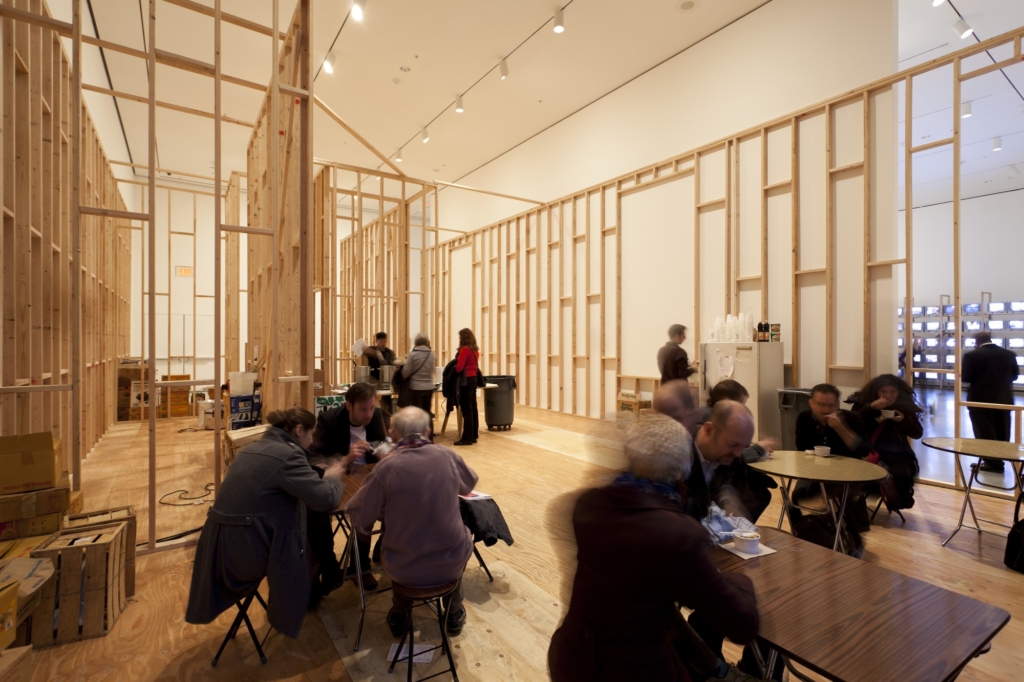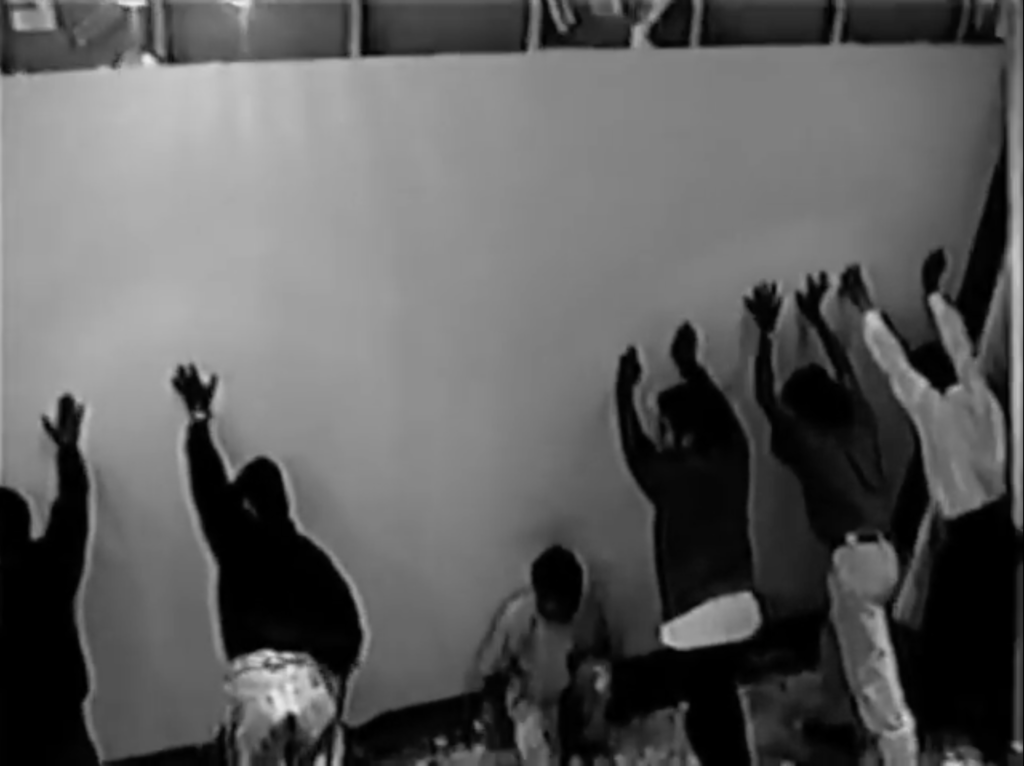Essay
Relational Antagonism
Artworks encourage inter-human action and discourse. Time and space are their basic materials to create periods and areas that are free, open and whose rhythms are different than in our everyday life. The people that are part of the “art world” use art spaces such as galleries, museums and art fares as the privilege places for exchanging values. Relational Aesthetics is trying to democratize these values and grow the sphere of human relationships and intercourse with no-gallery-goers. Relational art is about the encounter, proximity and the resistance to the social format. They seek the establishment of inter-subjective encounters even tough this might be potential.
Humans tend to be scared of the feeling of displacement or the threat of their own self by the presence of people that are not part of their comfort zone. Nicolas Bourriaud proposes that art should be installed in a social gap, in those zones that scape from the economical activity; but in fact the piece by it self becomes the “social gap”. The artwork is introducing a model of organization, a new shape of institution; something that can be translated to everyday life or something that can be appropriated by the receptor, which is no longer conceived as a passive spectator but as an agent that interacts with the artistic proposition. We can say, in other words, that the audience is visualized as a community and they are not just pointed as an entity but they are the material, the recourses to make a community. But what I wonder here is if they achieved to make the community they are looking for.
The structure of an artwork produces a social relationship and, in Relational Aesthetics, that might not be the struggle. Identifying the rational structure of a piece from this nature (since is it’s open-ended) is the conflict. And for Bourriaud, structure is the subject of matter. There is no sense in what medium of art installation is, and relational art is conceived by the presence of people. So, how do we decide what the structure of a relational artwork compromises? To make a structural identity we are dependent on identification in order to proceed. Subjectivity is the process of identification; therefore, antagonism is the relationship that emerges between such incomplete entities. Antagonism allows incompatibility, opposition and rivalry between opinions that creates the process so we can get to a higher intellectual space. As Claire Bishop sees it, without antagonism society land in a total suppression of argument, debate and discussion, which brings us to authoritarian order, far from democracy. Now we have to think, “how contemporary art addresses the viewer and to assess the quality of the audience relations it produces (…) and the democratic notions [the artwork] upholds, and how these are manifested in our experience of the work” (Bishop, 2004).

The artist Rikrit Tiravanija, raised in Thailand, Canada and Ethiopia but born in Buenos Aires and based in New York has lived globalization himself. He created the piece Untitled (Free/Still), 1992 that could be seen as a response to the virtual relationships and globalization and the need they produce to have relations face-to-face. In this peace Tiravanija (in resume) cooks Vegetable Curry or Pad Thai to the audience attending the performance and ‘everybody’is invited. This takes place at a gallery or museum where he’s commissioned to work. The object of this piece is the convivial relationship that the people in the audience develop offering an experience of togetherness. But as Bishop asks herself in her essay “who is ‘everyone’ here?” we start to think that only gallery-goers will attend to the performance and the social differ as well as the democratic notions it upholds are conceived weak. Since there is no presence of ‘others’, the visitors don’t feel their identity is precarious so there is no democratic gesture. It’s only political because it encourages dialogue instead of monologue. They could be themselves completely. Untitled (Free/Still), 1992 is only gathering a community in which members identify with each other, it was almost a place to build a network.

Democracy is not a simple two-way relationship between the system or socio-political environment we are living now and the civilized, enlightened demonstration of its mistakes and failures. Democracy is antagonism and this is reflected in the fact that art and society are base in different spheres. Relational artists like Santiago Sierra, Thomas Hirschhorn and Christoph Büchel are aware of this. In 2011, Büchel created Piccadilly Community Centre; this piece was an actual community center, with fully functioning classes, workshops and events. For the time that PCC (Piccadilly Community Centre) was active, the gallery Hauser & Wirth had completely changed their space. Their webpage would send you directly to the page for the PCC and there was no particular awareness that this was an art installation by the Swiss artistBüchel. He was trying the limits of art as an immaterial institution for the people that recognize it. The fact that many participants –such as volunteers, and participants of the workshops– ignore the evidence that this was an art installation offered an indispensable part for the work and it’s effects. One of the most important distinctions between Tiravanija’s and Büchel’s piece is that while at Untitled (Free/Still) there is only the presence of gallery-goers, in PCC there was “two distinct categories of visitors: community-center users and art viewers” (Farquharson, 2011).
Büchel achieved to make more democratic artwork in the sense that the boundaries of both social and aesthetic spheres come together in one space. PCC presented different ‘institutions’ not entirely separated and shows at the same time the segregation between the two entities. Just like Sierra and Hirschhorn, he’s making the art viewers disrupted form their identity. He brings out the psychological matter of making people feel threat because the presence of ‘others’ makes them change their own-self. The gallery-goers feel discomfort, displacement rather than belonging in what used to be their comfort zone. It sustains the tension and re-enforced the idea of the precarious identity. Büchel is trying to remind that the appearance of “antagonism [at a social level] can be viewed as the limits of society’s ability to fully constitute itself” (Bishop, 2011) and that the hard part is not talking to strangers from the same community, but the social division is there and we feel intimidated when we don’t relate. We start questioning our own self.

The focus in the comparison between the two pieces could be driven to the question: who is making a better democratic approach? But as I’ve been mentioning before, there is another factor in the pieces that becomes more psychological. Trough discomfort Büchel is showing that there is a context that is being ignored in Relational Aesthetics artworks. Contemporary art has new trends in its criticism. As Bishop also mentions, the judgment of aesthetics has been transformed (attacked, in her words) by postmodernism. Today politics, morals and ethical judgments are part of the judgment. Even though all this factors come up for the criticism, the art world doesn’t consider that there is a separation between art and society but Büchel is showing this two are different spheres. He’s making the audience question things they avoid to thing because it’s just uncomfortable. The society tends to think that they do talk about politics and democracy, but they don’t do it positioning them in ‘discomfort’. Chloe Nelkin mentions in a review “I felt lost – I went in and out a fair few times before being brave enough to explore the whole building. Some people are making full use of the center. But, many of us are wandering around like headless chickens not really knowing what to do or where to go”, we see how the community center user were, basically, running the place now, removing the pretentious idea of the gallery.
References:
- Allen, Emma. Curry Up! ARTnews: USA, 20012
- Bishop, Claire. Antagonism and Relational Aesthetics. October 110: USA, 2004
- Bourriaud, Nicolas. Relational Aesthetics. Paperback: USA, 1998
- Farquharson, Alex. The Piccadilly Community Centre. ARTFORUM: USA, 2011
- Gillick, Liam. Letters and Responses: A Response to Claire Bishop’s “Antagonism and Relational Aesthetics”. October 115: USA, 2006
- McLeod Saul. Defense Mechanisms. Simply Psychology: USA, N.D.
- Nelkin, Chloe. True or False? The Piccadilly Community Centre at Hauser & Wirth. England, 2011
- Wenger, Rodolfo. La Estética Relacional de N. Bourriaud. Perspectivas Estéticas:Argentina, 2013